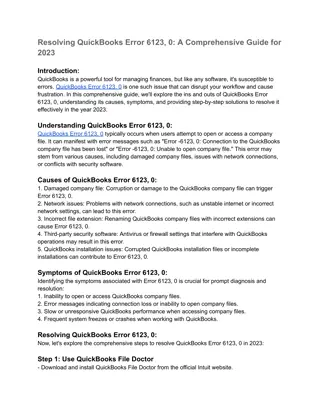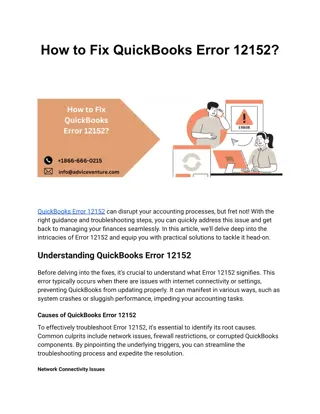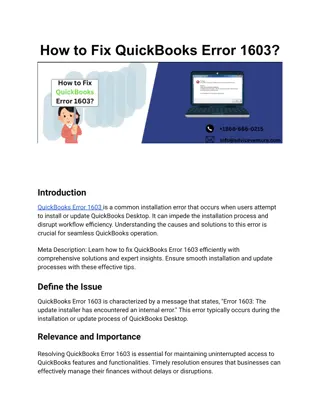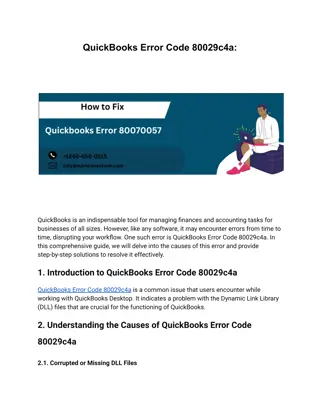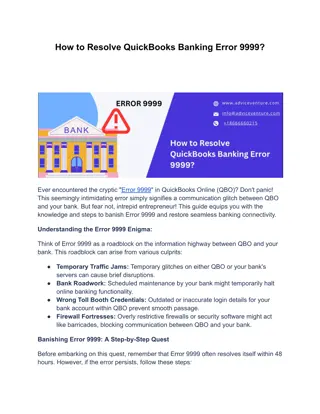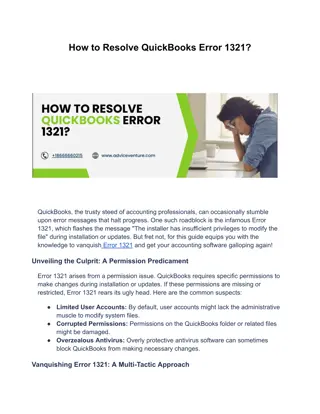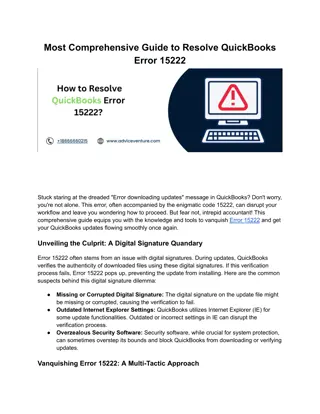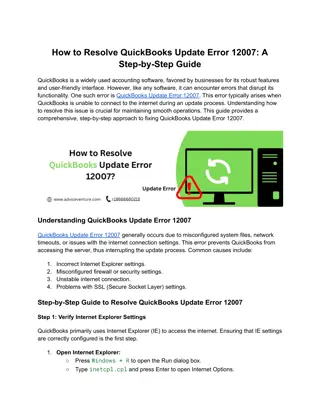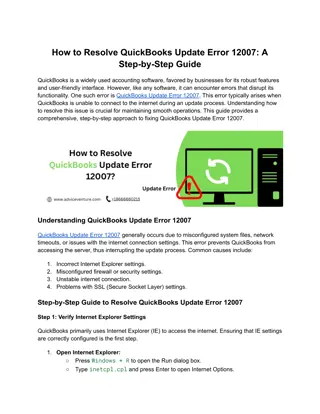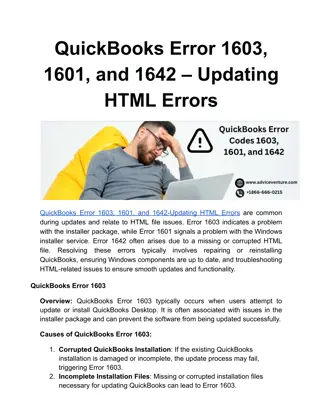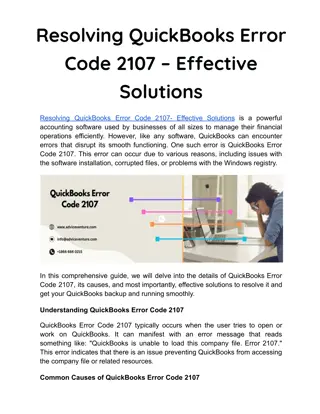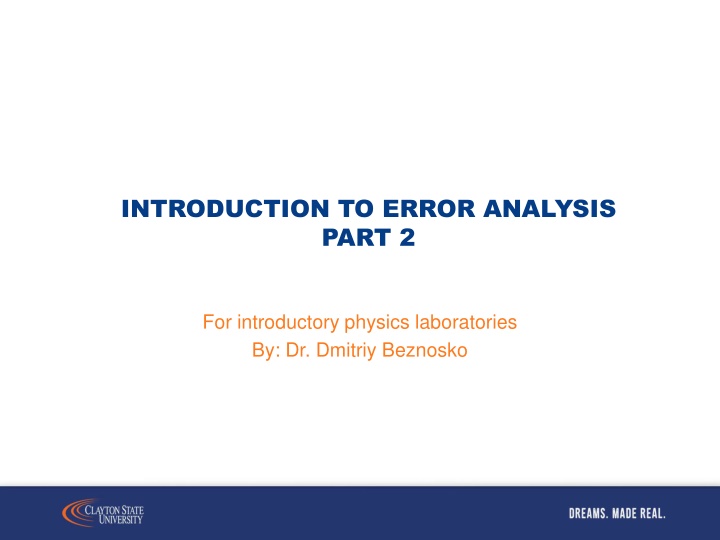
Error Analysis in Introductory Physics Laboratories
Explore error analysis in physics labs, focusing on estimation of measurement uncertainty and propagation to final quantities. Learn about error propagation, partial derivatives, and solving distance problems in 1D and 2D cases.
Download Presentation

Please find below an Image/Link to download the presentation.
The content on the website is provided AS IS for your information and personal use only. It may not be sold, licensed, or shared on other websites without obtaining consent from the author. If you encounter any issues during the download, it is possible that the publisher has removed the file from their server.
You are allowed to download the files provided on this website for personal or commercial use, subject to the condition that they are used lawfully. All files are the property of their respective owners.
The content on the website is provided AS IS for your information and personal use only. It may not be sold, licensed, or shared on other websites without obtaining consent from the author.
E N D
Presentation Transcript
INTRODUCTION TO ERROR ANALYSIS PART 2 For introductory physics laboratories By: Dr. Dmitriy Beznosko
INTRODUCTION Error analysis in general refers to the estimation of the measurement uncertainty (not the actual error !) and its propagation to the uncertainty in the final quantity we seek. Here we will only look at the error propagation For simple cases, there are shortcut formulas you can use First, we will look at the general case and then derive the shortcuts Note that this material is focused on developing the internal understanding of the process and not mathematical rigor, that will be introduced in lectures of appropriate courses
PROBLEM SETUP A car is moving with a velocity v for some time t. What is the total traveled distance if the error (that is, uncertainty) in the time measurement is t? Thus, the total travel time is ? ? We want to calculate distance ? ? t t r r r
SIMPLE CASE For simplicity (without the loss of generality) let s assume that ? is a function of some other parameters like weather ?, but it is not an explicit function of time ?: ? = ?(?) Then, ?(?) = ?(?) ? Side note: if ? were ?(?,?), then ?(?) must be the integral of ? ?? Note that r indirectly depends on w as well as on t In the intuitive way, we can say that ? = ?(?) ? Note: here we know ?(?) a rate of change of ?(?) from the start. But let s say we are given only ?(?) and need to find velocity first. r r r
GENERAL CASE IN 1D So, we are given ?(?) function and a measured value of ? ?, and we want to calculate a distance ? ? for that value. To do that, first we need the rate of change of the function ?(?) with respect to the variable we are interested in time. In a simple case, this rate of change is called velocity, but this process will work for any other variable as well. ? ? =??(?) ?? NOTE: Partial derivative is used! The simple way to feel why we use partial and not a full derivative is that we know from previous slides that ?(?) is a function too, therefore, in general, r is not only ?(?) but ?(?,?)! But here we want the rate of change of ? only with time, not with weather. And we did say that ? is independent of ?. ? ? =??(?,?) ??
GENERAL CASE IN 1D Then the answer to the standing problem with a car simply is: ? =??(?) ? ?? Since ?(?) is known, then we have solved out problem
y GENERAL CASE IN 2D Now ? is ?(??,??) y ??=??(?) x ?? ??? ??=??(?) ?? ??? Combining, we get 2+ ?? 2 r = ?? x x x
GENERAL CASE IN N DIMENSIONS If f is ?(?,?,?,?,? ), then 2 2 ?? ?? ? ?? ?? ? ? = + + Example: If ? = ??2sin(?), then 2 2 ?? ?? ? ?? ?? ? ? = + ?2sin ? + ??2cos(?)2 ?2+ 2????? ? ?2 =
SIMPLIFIED FORMULAS ????? ? ?,? ?,? ?: ?2+ ?2?????????? ?? ???? ? = ? ? ? = ????????????????? ?+? ? ???.: 2?????????????????????????? ? ?= ?? ? = ???, ? = ?? ? ?? 2 2 ? ? ? ? ? ? + + ? ?= ? ? ? ?? ? = ??,
EXAMPLE: ? =? + ?? + ? 7?5 ???5 See how many times each term is present. Note that A and A2 are different terms! Terms with power will have their power INSIDE the square 2 2 2 2 ? ? ? ? ? ? 7 ? ? 5 ? ? = 3 + 2 + + 2
SIMPLIFIED FORMULA DERIVATION Only one will be derived. Others are your homework We start with ? = ??. 2 ??? ?? ? = ? ?? 1 ? ?? ?? ? ?? ?? ? = ? ?? 1 ? ?? ? = = ? ?? 1 ? ? ? ?= QED ? ? = = ? ANY QUESTIONS?




